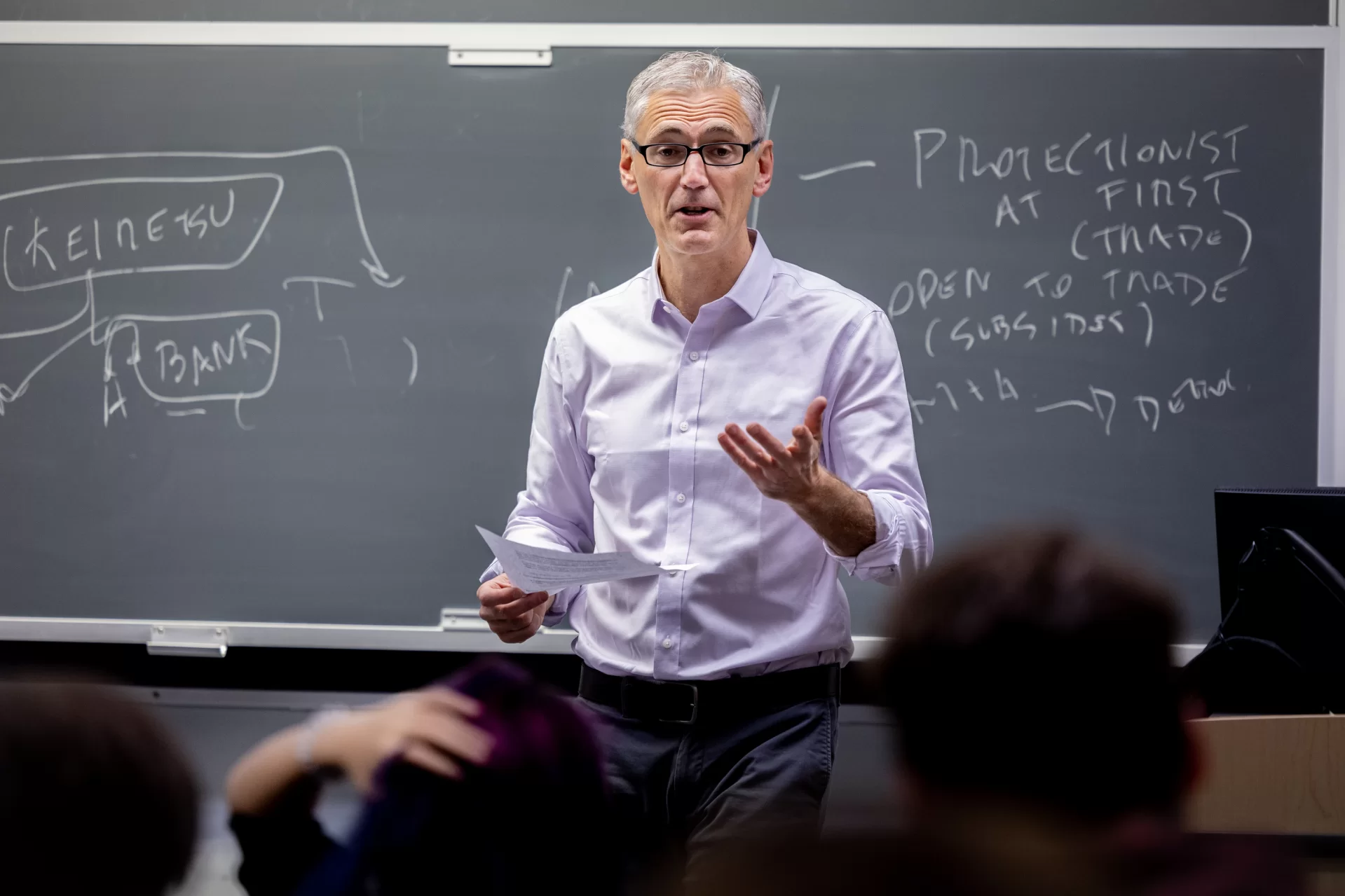
In “Economic Sociology,” Charles A. Dana Professor of Sociology Francesco Duina presents students with a social and philosophical question.
“I ask, ‘How many of you like a lot of inequality?’ Usually none of them raises their hands. But then I say, ‘How many of you would want perfect equality?’” He shakes his head. “Nobody raises their hand. They’ve never thought of that.”
Duina brings questions like these to his classes, never revealing much about his beliefs because his focus is on helping students examine their own tendencies.

“So, where are you and why? Why do you accept some degree of inequality?” he asks.
Students are thus encouraged to understand or at least see their own ways of justifying the world around them, including inequalities. His most recent book has a similar aim.
The Social Acceptance of Inequality: On the Logics of a More Unequal World (Oxford 2025), a collection that Duina co-edited with Luca Storti, an associate professor of economic sociology at the University of Turin, Italy, dives in deep on why people across the world accept economic inequalities (understood to be those related to income and wealth). The question is all the more salient because over the past several decades economic inequalities have in most cases grown a great deal. In other words, the real issue is actually not why small inequalities are accepted, but why massive amounts of inequalities are in fact accepted, and even approved of, by significant amounts of people.
Using four logics of acceptance as a framework for the vastly different contexts across the globe from which their 19 contributors write, the book makes visible to readers the assumptions, biases, and worldviews that people bring to their thinking about inequality.
This interview with Duina has been lightly edited for clarity and space.

Meredith McCarroll: You write, in the introduction, that while there is a range of feelings about increased economic inequalities, the aim of the book is to focus on “the logics by which these inequalities are accepted.” How did you and your co-editor come to determine the need for this volume?
Francesco Duina: Inequalities have gone up in most cases, and so we chose this because there’s so much written about how bad these things are and why they’re bad and what we can do about it. And there isn’t a whole lot written about why people accept them when they do. We were very eager to understand that acceptance — it is, after all, a major factor that sustains those inequalities and something that we may want to grasp if we in fact want to do something about those inequalities.
MM: So why an edited collection?
FD: Because matters are so complicated. If you’re really interested in the question of why economic inequalities are accepted across the world by a wide variety of people, you need extensive knowledge and expertise. No single person can have that. Who am I to write about Southeast Asia and Latin America and Scandinavia and the United States and China? We figured that if we collect various perspectives and voices, and we get a much bigger umbrella and better coverage, then we can really figure things out a little bit.
Of course, we recognize that there are works in different disciplines, such as economics or psychology, that point to single logics of acceptance. Our goal was to identify and contrast and compare all the major logics, and to see what we can conclude by doing so.
MM: You outline in the introduction four logics of acceptance: market/economic, moral, group, and cultural. Can you briefly describe those four logics?
FD: Sure. In a shorter piece that we are publishing about the book, by the way, we are actually calling them “justifications” for the inequalities. The term might be a little easier to grasp than ‘“logics” of acceptance.
So, when it comes to market/economic logics, people accept inequalities because they believe that they are byproducts of a well-functioning economic system. Trying to eliminate inequalities would mean that wealth production overall would be reduced, investments would go to the wrong places, innovation would be discouraged, and philanthropy would suffer. Importantly, these sorts of logics do not see inequalities as desirable but as inevitable outcomes to be tolerated given what else is being promoted.
Next, we have moral logics, which are based on notions of fairness and justice. In this case, inequalities are seen as actually something that is desirable. There is something good in them. For instance, if you worked hard you deserve to have more. And of course they take different articulations, including inheritance, where one might say, “Well, it’s my grandfather’s.” If asked, what does it have to do with you, we hear, “Well, in the end, it is fair that it comes to me rather than to somebody else because I am of that lineage.”
Group logics offer a third ground for acceptance. These are the hardest to see in practice … at least in their purest form. They are predicated on the idea that a group is, by virtue of who they are and not necessarily what they have done, entitled to more. The clearest example I can think of is the caste system in India. It’s preordained religiously. So the upper caste should have more — it doesn’t matter if they sit around and just do nothing — by virtue of who they are. You see articulations of this in Scandinavia. The Danes believe they are more entitled to the welfare system than immigrants. For instance, they resist giving those immigrants many years of unemployment benefits. Why? Well, some would say that it’s “because we’re Danes. They’re not.” Of course here many would quickly add that they have worked hard to contribute to that system — and in this regard their logic is also moral.
Racial distinctions are also at work in group logics. Gender distinctions, age distinctions, and even class distinctions fit into this mindset.
The fourth set of logics is cultural. In the case of the United States, for instance, the American Dream is a pervasive set of ideas that most people know about. Most of us grew up with it, and assume it is a fair description of what life in this society is like. You’re going to go from poor to rich if you do the right things. It is easy to see how someone who is born and raised in this cultural milieu might be quite likely to tolerate inequalities. Inequalities “make sense’” given what Americans know about their society and world.

MM: What is new about your volume? What contributions do you see it making to the field or beyond?
FD: Multiple perspectives and an appreciation for the fact that economic and wealth inequalities manifest themselves in different settings. And that the same inequality means different things in different places, comes from different places, is or is not problematic in different ways, and is sustained in similar or different ways. Sometimes we find the same logics at work across the world. Others can be more very peculiar to a place. The collection offers an ability to see how the logics themselves compare to, and differ from, each other.
MM: What role do you hope the book might play in terms of solutions to this problem of growing inequality?
FD: There is already so much written on solutions. We knew that if we wanted to stay consistent with the message of the book, we needed to focus on the logics. We are therefore asking whether there are things in the logics themselves that someone interested in reducing inequalities could tackle. Are there unfounded biases in the logics? Are there faulty assumptions? If the logics themselves inherently have contradictions and or faulty elements, highlighting those things could dissuade some people at least from embracing them
MM: Are there ways that this approach shows up in your teaching? Is part of your work making the invisible visible? Just allowing students to see that this is part of what’s shaping their core understanding of inequality or fairness?
FD: Yes. I think my role is to shed light on things. Then students can draw their own conclusions, but the light helps to dissipate the cloudiness and the fog. That’s my goal.



